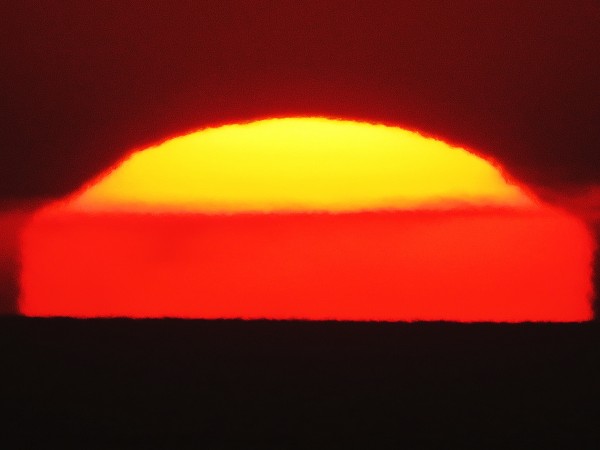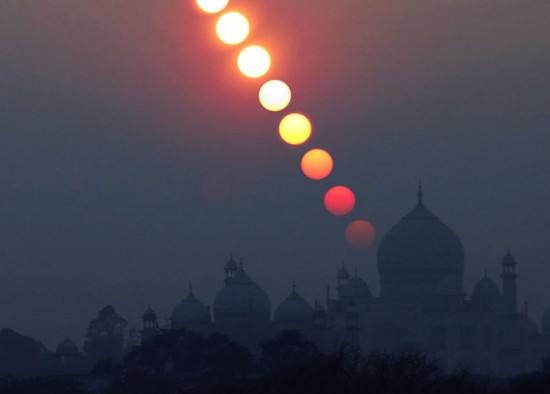
Flattened sunset by Helio de Carvalho Vital in Rio de Janeiro, Brazil. A flattened sunset is an effect of atmospheric refraction. Refraction also gives us a few more minutes of daylight on the equinox than we would have otherwise.
The upcoming equinox – the Northern Hemisphere’s autumn equinox and the Southern Hemisphere’s spring equinox – falls at 8:21 Universal Time on Wednesday, September 23, 2015. For North American time zones, that’s September 23 at 4:21 a.m. EDT, 3:21 a.m. CDT, 2:21 a.m. MDT or 1:21 a.m. PDT. Twice a year – on the March and September equinoxes – everyone worldwide supposedly receives 12 hours of day and 12 hours of night. Generally speaking, that’s true. But, precisely speaking, there is more daylight than nighttime on the day of the equinox, an additional 8 or so minutes of daylight, at mid-temperate latitudes. There are two reasons why we have more than 12 hours of daylight on this day of supposedly equal day and night. They are:
The sun is a disk, not a point
Keeping reading to understand more about why …
The sun is a disk, not a point. Watch any sunset, and you know the sun appears in Earth’s sky as a disk.
It’s not pointlike, as stars are, and yet – by definition – most almanacs define sunrise as when the top of the sun first touches the eastern horizon. They define sunset as when the sun’s upper limb finally touches the western horizon.
This in itself provides an extra 2.5 to 3 minutes of daylight at mid-temperate latitudes.

Atmospheric refraction actually raises the sun about 1/2 degree upward at sunrise and sunset. This advances the sunrise yet retards the sunset, adding several minutes of daylight at each end of the day. Image via Wikipedia
Atmospheric refraction. The Earth’s atmosphere acts like a lens or prism, uplifting the sun about 0.5o from its true geometrical position whenever the sun nears the horizon. Coincidentally, the sun’s angular diameter spans about 0.5o, as well.
Therefore, atmospheric refraction advances the sunrise and delays the sunset, adding nearly another 6 minutes of daylight at mid-temperate latitudes.
Astronomical almanacs usually don’t give sunrise or sunset times to the second. That’s because atmospheric refraction varies somewhat, depending on air temperature, humidity and barometric pressure. Lower temperature, higher humidity and higher barometric pressure all increase atmospheric refraction.
On the day of the equinox, the center of the sun would set about 12 hours after rising – given a level horizon, as at sea, and no atmospheric refraction.
Bottom line: There are two reasons why we have more than 12 hours of daylight on the day of equinox. First, the sun is a disk, not a point of light. Second, the Earth’s atmosphere refracts (bends) sunlight. These factors add up to provide an additional 8 or so minutes of daylight on the day of the equinox at mid-temperate latitudes.
© 2014 Earthsky Communications Inc
http://earthsky.org/space/why-arent-day-and-night-equal-on-the-day-of-the-equinox

